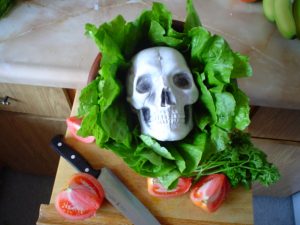Escherichia coli O157:H7 (EcO157) infections have been recurrently associated with produce. The physiological state of EcO157 cells surviving the many stresses encountered on plants is poorly understood. EcO157 populations on plants in the field generally follow a biphasic decay in which small subpopulations survive over longer periods of time. We hypothesized that these subpopulations include persister cells, known as cells in a transient dormant state that arise through phenotypic variation in a clonal population.
 Using three experimental regimes (with growing, stationary at carrying capacity, and decaying populations), we measured the persister cell fractions in culturable EcO157 populations after inoculation onto lettuce plants in the laboratory. The greatest average persister cell fractions on the leaves within each regime were 0.015, 0.095, and 0.221%, respectively. The declining EcO157 populations on plants incubated under dry conditions showed the largest increase in the persister fraction (46.9-fold). Differential equation models were built to describe the average temporal dynamics of EcO157 normal and persister cell populations after inoculation onto plants maintained under low relative humidity, resulting in switch rates from a normal cell to a persister cell of 7.7 × 10−6 to 2.8 × 10−5 h−1. Applying our model equations from the decay regime, we estimated model parameters for four published field trials of EcO157 survival on lettuce and obtained switch rates similar to those obtained in our study. Hence, our model has relevance to the survival of this human pathogen on lettuce plants in the field. Given the low metabolic state of persister cells, which may protect them from sanitization treatments, these cells are important to consider in the microbial decontamination of produce.
Using three experimental regimes (with growing, stationary at carrying capacity, and decaying populations), we measured the persister cell fractions in culturable EcO157 populations after inoculation onto lettuce plants in the laboratory. The greatest average persister cell fractions on the leaves within each regime were 0.015, 0.095, and 0.221%, respectively. The declining EcO157 populations on plants incubated under dry conditions showed the largest increase in the persister fraction (46.9-fold). Differential equation models were built to describe the average temporal dynamics of EcO157 normal and persister cell populations after inoculation onto plants maintained under low relative humidity, resulting in switch rates from a normal cell to a persister cell of 7.7 × 10−6 to 2.8 × 10−5 h−1. Applying our model equations from the decay regime, we estimated model parameters for four published field trials of EcO157 survival on lettuce and obtained switch rates similar to those obtained in our study. Hence, our model has relevance to the survival of this human pathogen on lettuce plants in the field. Given the low metabolic state of persister cells, which may protect them from sanitization treatments, these cells are important to consider in the microbial decontamination of produce.
IMPORTANCE Despite causing outbreaks of foodborne illness linked to lettuce consumption, E. coli O157:H7 (EcO157) declines rapidly when applied onto plants in the field, and few cells survive over prolonged periods of time. We hypothesized that these cells are persisters, which are in a dormant state and which arise naturally in bacterial populations. When lettuce plants were inoculated with EcO157 in the laboratory, the greatest persister fraction in the population was observed during population decline on dry leaf surfaces. Using mathematical modeling, we calculated the switch rate from an EcO157 normal to persister cell on dry lettuce plants based on our laboratory data. The model was applied to published studies in which lettuce was inoculated with EcO157 in the field, and switch rates similar to those obtained in our study were obtained. Our results contribute important new knowledge about the physiology of this virulent pathogen on plants to be considered to enhance produce safety.
Formation of Escherichia coli O157:H7 persister cells in the lettuce phyllosphere and application of differential equation models to predict their prevalence on lettuce plants in the field
08 November 2019
Applied and Environmental Microbiology
Daniel S. Munther, Michelle Q. Carter, Claude V. Aldric, Renata Ivanek, Maria T. Brandl
DOI: 10.1128/AEM.01602-19
